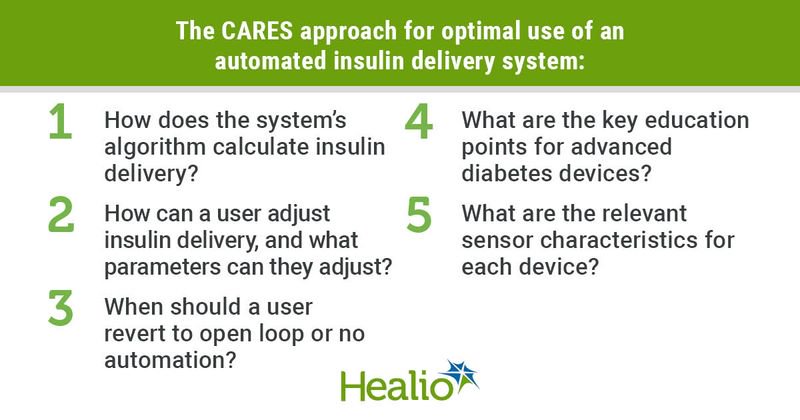ADA issues practical advice for use of automated insulin delivery systems
Open communication between stakeholders and patient education are two underlying themes in a new series of recommendations provided in a consensus report on the use of automated insulin delivery systems.
In an article published in Diabetologia, representatives from the American Diabetes Association and the European Association for the Study of Diabetes drafted recommendations for regulatory agencies, manufacturers, health care professionals, patients and more to follow with the use of automated insulin delivery systems.

“The report addresses the clinical usage of automated insulin delivery systems from a practical point of view rather than as a meta-analysis or a review of all relevant clinical studies,” Jennifer Sherr, MD, PhD, professor of pediatrics in the department of pediatric endocrinology at Yale University, said in a press release. “As such, the benefits and limitations of systems are discussed while also considering safety, regulatory pathways and access to this technology.”

Researchers acknowledged that evidence has shown automated insulin delivery is associated with improvements in HbA1c as well as time in range. However, several limitations persist with use of the devices, including lag time in sensor glucose values; technological concerns, such as missing sensor glucose data, insulin set failures, and possible server interruptions; and behavioral limitations, such as the requirement to correct boluses and the need for problem-solving skills to correct hyperglycemia.
Initiating use of automated insulin delivery
When considering automated insulin delivery for a person with diabetes, providers need to effectively communicate expectations and explain what the system’s strengths and limitations are. Instructions should be supplied on how to dose insulin if the system fails, and consideration should be given to the possibility of running out of supplies due to shortages, especially when supply chain issues persist.
“Educating patients with diabetes on automated insulin delivery system functionality and how to determine whether insulin delivery is being increased or suspended may allow for trust to be established with this automated process,” the researchers wrote.
From a clinical perspective, a help line staffed by someone with experience caring for diabetes and using diabetes devices may be best for providing support for patients. Diabetes manufacturers should also have a hotline available in case of an unknown device failure. Staffers for this hotline should be well informed on how to assist users if a system or one of its components needs to be replaced.
The researchers proposed a systematic approach for the optimal use of diabetes devices called Calculate, Adjust, Revert, Educate and Sensor/Share, or CARES. Under this approach, providers should
- Consider how the algorithm calculates insulin delivery.
- Discover how the user can adjust insulin delivery and what parameters can be altered.
- Determine when a user should revert to no automation and when the system will switch to no automation.
- Name the key education points for advanced diabetes devices.
- Determine the relevant sensor characteristics and system capabilities for each device.
Discontinuing automated insulin delivery for a time may be the right choice in certain situations, according to the authors.
“It may not be prudent to continue with automated insulin delivery in certain situations, and patients may be instructed to revert to conventional continuous subcutaneous insulin infusion,” the researchers wrote. “These situations include illness, when there may be temporarily increased insulin resistance and elevated glucose levels, as well as reduction in oral intake and ketosis without elevated glucose levels.”
When determining whether a patient is capable of using an automated insulin delivery system, providers should consider a person’s capability of using the technology, whether the patient had a realistic expectation of the system, whether they completed appropriate training and whether they are mentally and psychologically able to fulfill the requirements for successful implementation.
Do-it-yourself systems not endorsed
The researchers noted safety requirements for automated insulin delivery are similar to continuous glucose monitoring. Both patients and providers are advised to be up-to-date on any recalls and device safety updates. All stakeholders should remain vigilant about cybersecurity, and the authors advocated for continuous testing of components and systems to safeguard devices.
Approval of automated insulin systems differs between the U.S. and Europe. The authors noted that while the FDA has quickly approved systems in the past, the European Commission lacks a similar pathway for the approval of diabetes devices.
For do-it-yourself insulin delivery systems, the authors caution that the entry bar for patients is high and do-it-yourself systems are not recommended by regulatory agencies or scientific societies due to a lack of current evidence on safety and the risk-benefit balance, as well as unsolved liability issues. The researchers gave several recommendations to providers if they are asked about do-it-yourself systems.
“The provider should tell the individual that these systems are not approved by regulatory agencies, which in turn means that the manufacturer of the components used to build such a system are not liable,” the researchers wrote. “The provider should tell the individual that, although these systems cannot be prescribed by a provider, and the patient assumes responsibility for their use, the provider can make recommendations regarding patient safety and assist with developing a backup plan in case the system fails.”
In addition, providers should document or report any issues that a patient may experience with use of a do-it-yourself system.
